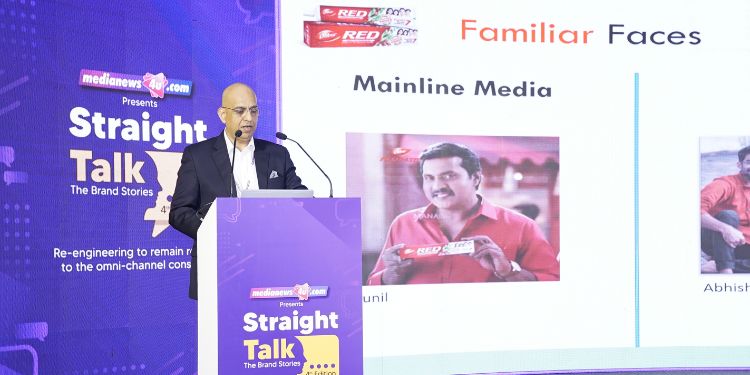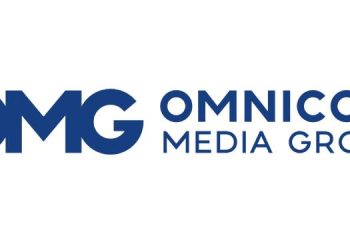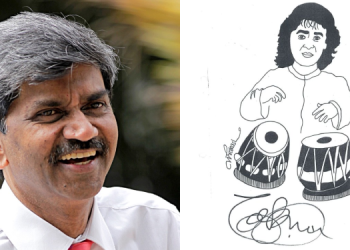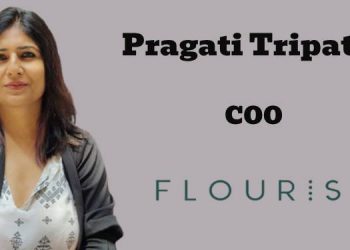“As a company what Colgate spends across one brand, we spend across 40 brands, that’s the difference between them and us and we can’t beat them in terms of GRPs or share of voice. But we can beat them in some fields; we choose certain programmes/genres and try to outshot them there. (For example) In Andhra Pradesh there’s a program called ‘Karthika Deepam’ on Star Maa, in Tamil Nadu a programme called ‘Baakiyalakshmi’; we have been dominating these programmes for a number of years,” explained Rajiv Dubey, Head – Media, Dabur, speaking at the 4th edition of MediaNews4u.com Straight Talk 2022 in Chennai on 18 November 2022.
He was addressing a question on Dabur admittedly spending less than Colgate but being the market leader in several states, as part of a panel discussion alongside Vishal Vyas, AVP – Marketing, TTK Healthcare, moderated by Gokul Krishnamoorthy, Consulting Editor, MediaNews4u.com.
The Rs.11,000 crore company sees 20pc of the business from the South, revealed Dubey. While its toothpastes have 16.5pc market share nationally, the number is substantially higher in South and East. Dabur Red is the market leader in Tamil Nadu and West Bengal with over 25pc market share in each, besides Orissa (37pc) and Andhra Pradesh (30pc), he noted.
Dabur’s hair oils have 16pc share, homecare brands over 40pc, and digestives and baby oils have high double digit shares nationally, noted the spokesperson.
Around 25pc of all toothpastes sold today in India are ayurvedic, noted the spokesperson, adding that Dabur was the first to introduce one over a decade ago.
“Adoption of ayurvedic toothpaste has been very good. We have spent money in media but not as much as Colgate,” he added.
Growth in the South
Dabur, which has a strong brand portfolio from Chyavanprash to Vatika to many more, has a presence today in 69 lakh outlets with a thrust on distribution.
“The South market was untouched for several decades. We started focusing in these markets and our contribution in business from the South had increased from 10pc to 20pc in the last few years,” noted Dubey.
During Covid, when people stocked up on FMCG products, the South markets were growing at 30pc, twice the rate of the rest of the country.
A conscious effort to woo the South consumer was also made through regionally relevant brand ambassadors and associations across all South markets. Sponsorship of shows like ‘Big Boss’ with Kamal Hassan in Tamil Nadu ‘worked really well’, added the spokesperson.
On digital too, influencers from each of the regions have been engaged. “In South India alone in the last one year we have used over 3500 influencers across four markets put together for different products,” said Dubey.
In line with the omni-channel theme of Straight Talk, Dabur’s is a case where there is engagement across print, radio, TV and digital, including influencer marketing on social media. For the recent launch of a new premium offering ‘Vatika Neelibhringa Hair Oil’ priced at Rs.200, the brand was announced through the front pages of Vijay Karnataka and Daily Thanthi. The company also got influencers to come and talk about the brand.
Online Sales and Spends
The pre–pandemic share of e-commerce for Dabur was 1pc. Today it stands at 8pc, which Dubey claims is the highest for any FMCG major in India.
“We don’t sell the same products that we sell in the retail market. We sell products that are premium offerings, slightly differentiated. In e-commerce if you sell the same products which you sell in the rest of the market, you end up losing money because the margins are different,” he explained.
Share of e-commerce which went up during the pandemic has remained at 8pc while modern trade, which had dropped, is also picking up now, according to the Dabur spokesperson. There is no cannibalisation because of the different products sold online, he underlined.
Dubey said, “Modern trade and e-commerce put together is almost 20 to 25pc of the business right now. In the South, it’s still higher, more than 30pc. It’s not at the cost of any other businesses, its exclusive business. We have tried to sell bigger formats, premium offerings, differentiated products and that has really helped us.”
In line with the rise in online sales, digital spends accounted for 25pc of the total media spends in the first quarter of the year. As on date, it has gone up to 33pc (albeit aided by a drop in total spends).
Dubey observed, “We continue to spend money on digital and it is giving immediate, good results.”

















